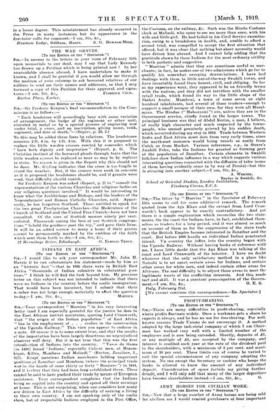[To men EDITOR or THE " SPECTATOR.") SIR,—Sir Frederic Kenyon's
final recommendation to the Com- mission is as follows i-
" Each headstone will accordingly bear with some varieties of arrangement, the badge of the regiment or other unit, executed in metal or by a special process of engraving now under trial, a cross, and an inscription, giving name, rank, regiment, and date of death."—(Report, p. 23, 2.) To this may be added three lines by relative.. The headstones measure 2ft. 6 in. by 1 ft. Sin. With this it is proposed to replace the little wooden crosses erected by comrades which have both dignity and inspiration" (Report, p. 6). The Christian instinct of the bereaved pleads through tears that the little wooden crosses be replaced as near as may ho by replicas in stone. No reason is given in the Report why this should not be done. Mr. Kipling indicates that the cross is too fragile to stand the weather. But, if the crosses were sunk in concrete as it is proposed the headstones should be, and if granite were used, that difficulty should vanish.
Sir Frederic Kenyon was asked (Report, p. 2) to " consult the representatives of the various Churches and religious bodies on any religious questions involved." it would be interesting to know what the Archbishops and Bishops, and the leaders of the Nonconformist and Roman Catholic Churches, said. Appar- ently, he has forgotten Scotland. Those entitled to speak for the two great Presbyterian Churches—the Moderators of the Church of Scotland and the United Free Church—have not been consulted. Of the sons of Scottish manses ninety per cent. enlisted. Thousands among the best of our Scottish congrega- tions " beheld the goodness past the toy," and gave their lives. It will be an added sorrow to many a home if their graves cannot be permanently marked by the emblem of the faith a }dell sent them forth to die.—I am, Sir, &e.,
22 Hermitage Dcire, Edinburgh. O. ELMSLIE TROre.


































 Previous page
Previous page